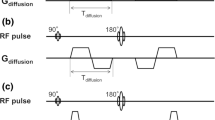Abstract
Purpose
To investigate changes in brain temperature according to the menstrual cycle in women using diffusion-weighted imaging (DWI) thermometry and to clarify relationships between brain and body temperatures.
Materials and methods
In 20 healthy female volunteers (21.3–38.8 years), DWI of the brain was performed during the follicular and luteal phases to calculate the brain temperature. During DWI, body temperatures were also measured. Group comparisons of each temperature between the two phases were performed using the paired t test. Correlations between brain and body temperatures were analyzed using Pearson’s correlation coefficient test.
Results
Mean diffusion-based brain temperature was 36.24 °C (follicular) and 36.96 °C (luteal), showing a significant difference (P < 0.0001). Significant differences were also seen for each body temperature between the two phases. Correlation coefficients between diffusion-based brain and each body temperature were r = 0.2441 (P = 0.1291), –0.0332 (0.8387), and –0.0462 (0.7769), respectively.
Conclusions
In women of childbearing age, brain and body temperatures appear significantly higher in the luteal than in the follicular phase. However, brain and body temperatures show no significant correlations.



Similar content being viewed by others
References
Kelly G. Body temperature variability (Part 1): a review of the history of body temperature and its variability due to site selection, biological rhythms, fitness, and aging. Altern Med Rev. 2006;11:278–93.
Kiyatkin EA. Brain temperature homeostasis: physiological fluctuations and pathological shifts. Front Biosci. 2010;15:73–92.
Fuller CA. Circadian brain and body temperature rhythms in the squirrel monkey. Am J Physiol. 1984;246:242–6.
Schwab S, Spranger M, Aschoff A, Steiner T, Hacke W. Brain temperature monitoring and modulation in patients with severe MCA infarction. Neurology. 1997;48:762–7.
Rumana CS, Gopinath SP, Uzura M, Valadka AB, Robertson CS. Brain temperature exceeds systemic temperature in head-injured patients. Crit Care Med. 1998;26:562–7.
Mariak Z, Lebkowski W, Lyson T, Lewko J, Piekarski P. Brain temperature during craniotomy in general anesthesia. Neurol Neurochir Pol. 1999;33:1325–37.
Le Bihan D, Delannoy J, Levin RL. Temperature mapping with MR imaging of molecular diffusion: application to hyperthermia. Radiology. 1989;171:853–7.
Corbett RJ, Purdy PD, Laptook AR, Chaney C, Garcia D. Noninvasive measurement of brain temperature after stroke. Am J Neuroradiol. 1999;20:1851–7.
Kuroda K, Takei N, Mulkern RV, et al. Feasibility of internally referenced brain temperature imaging with a metabolite signal. Magn Reson Med Sci. 2003;2:17–22.
Karaszewski B, Wardlaw JM, Marshall I, et al. Measurement of brain temperature with magnetic resonance spectroscopy in acute ischemic stroke. Ann Neurol. 2006;60:438–46.
Kozak LR, Bango M, Szabo M, Rudas G, Vidnyanszky Z, Nagy Z. Using diffusion MRI for measuring the temperature of cerebrospinal fluid within the lateral ventricles. Acta Paediatr. 2010;99:237–43.
Sakai K, Yamada K, Sugimoto N. Calculation methods for ventricular diffusion-weighted imaging thermometry: phantom and volunteer studies. NMR Biomed. 2012;25:340–6.
Yamada K, Sakai K, Akazawa K, et al. Moyamoya patients exhibit higher brain temperatures than normal controls. NeuroReport. 2010;21:851–5.
Tazoe J, Yamada K, Sakai K, Akazawa K, Mineura K. Brain core temperature of patients with mild traumatic brain injury as assessed by DWI-thermometry. Neuroradiology. 2014;56:809–15.
Sai A, Shimono T, Sakai K, et al. Diffusion-weighted imaging thermometry in multiple sclerosis. J Magn Reson Imaging. 2014;40:649–54.
Sakai K, Yamada K, Mori S, Sugimoto N, Nishimura T. Age-dependent brain temperature decline assessed by diffusion-weighted imaging thermometry. NMR Biomed. 2011;24:1063–7.
Tassorelli C, Sandrini G, Cecchini AP, Nappi RE, Sances G, Martignoni E. Changes in nociceptive flexion reflex threshold across the menstrual cycle in healthy women. Psychosom Med. 2002;64:621–6.
Kido A, Kataoka M, Koyama T, Yamamoto A, Saga T, Togashi K. Changes in apparent diffusion coefficients in the normal uterus during different phases of the menstrual cycle. Br J Radiol. 2010;83:524–8.
Cagnacci A, Soldani R, Laughlin GA, Yen S. Modification of circadian body temperature rhythm during the luteal menstrual phase: role of melatonin. J Appl Physiol. 1996;80:25–9.
Mills R. Self-diffusion in normal and heavy water in the range 1–45 degrees. J Phys Chem. 1973;77:685–8.
Sakai K, Sakamoto R, Okada T, Sugimoto N, Togashi K. DWI based thermometry: the effects of b-values, resolutions, signal-to-noise ratio, and magnet strength. Conf Proc IEEE Eng Med Biol Soc. 2012;2012:2291–3.
Boulant JA. Role of the preoptic-anterior hypothalamus in thermoregulation and fever. Clin Infect Dis. 2000;31:157–61.
Stachenfeld NS, Silva C, Keefe DL. Estrogen modifies the temperature effects of progesterone. J Appl Physiol. 2000;88:1643–9.
McEwen BS, Pfaff DW. Hormone effects on hypothalamic neurons: analysing gene expression and neuromodulator action. Trends Neurosci. 1985;8:105–10.
Baker FC, Waner JI, Vieira EF, Taylor SR, Driver HS, Mitchell D. Sleep and 24 hour body temperatures: a comparison in young men, naturally cycling women and women taking hormonal contraceptives. J Physiol. 2001;530:565–74.
Hwang PYK, Lewis PM, Maller JJ. Use of intracranial and ocular thermography before and after arteriovenous malformation excision. J Biomed Opt. 2014;19:110503.
Campbell I. Body temperature and its regulation. Anaesth Intensive Care. 2011;12:240–4.
Sund-Levander M, Forsberg C, Wahren LK. Normal oral, rectal, tympanic and axillary body temperature in adult men and women: a systematic literature review. Scand J Caring Sci. 2002;16:122–8.
Author information
Authors and Affiliations
Corresponding author
Ethics declarations
Conflict of interest
Yukio Miki received a research grant from JSPS KAKENHI (grant no. 25461842). The other authors have no conflict of interest directly relevant to the content of this article.
About this article
Cite this article
Tsukamoto, T., Shimono, T., Sai, A. et al. Assessment of brain temperatures during different phases of the menstrual cycle using diffusion-weighted imaging thermometry. Jpn J Radiol 34, 277–283 (2016). https://doi.org/10.1007/s11604-016-0519-5
Received:
Accepted:
Published:
Issue Date:
DOI: https://doi.org/10.1007/s11604-016-0519-5




